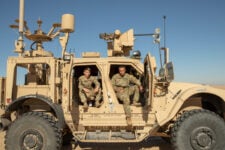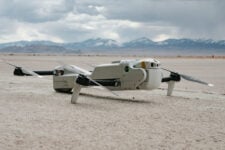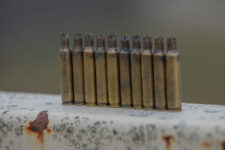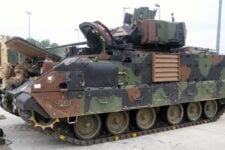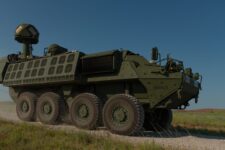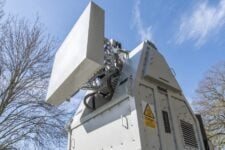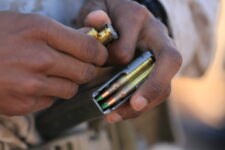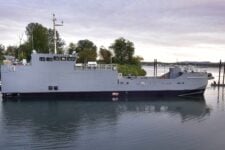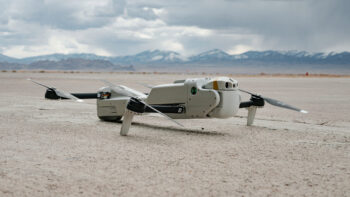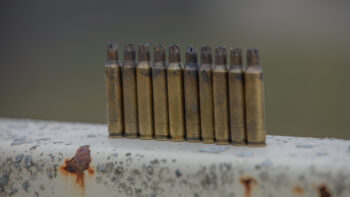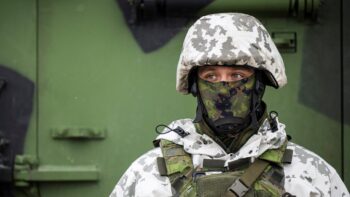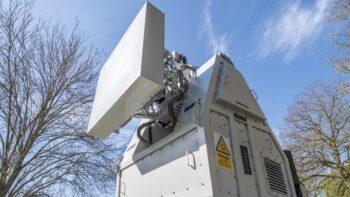
Rockets fired by Palestinian militants from Gaza City are intercepted by the Israeli Iron Dome defense missile system in the early hours of Oct. 8. (Eyad Baba/AFP via Getty Images).
WASHINGTON — The US Army’s two Iron Dome batteries are still in transit to Israel, according to a senior service official. And it seems the Army isn’t expecting them to come back anytime soon.
The deal with Israel was done under a “cost to lease under an [foreign military sales] FMS case: [It] was the fastest way to get Israel the Iron Dome batteries and the missiles,” Army acquisition head Doug Bush told reporters today, providing the most detailed explanation the service has given since it announced plans to ship the two batteries to Israel in the wake of the Oct. 7 attacks by Hamas.
For now, that deal is for 11-months and involves a “small amount of money … with pay back to be determined,” he added. However, that arrangement could be extended “depending on factors on the ground.”
“It was the fastest way to do it, so that’s why we went with that,” Bush said.
After the Hamas attack, Washington began sending Israel military aid packages including Tamir interceptors for its Iron Dome launchers to use against incoming rockets. Then late last month, the Pentagon announced it would also ship the Army’s only two Iron Dome batteries back to Israel.
While those batteries are now bound for a new, temporary home, there has been dissent within the Army about their fate for years.
Army leaders bought the pair of batteries following a Congressional mandate to acquire an interim air defense capability. However, service officials have raised cybersecurity concerns about integrating the Israeli-made batteries into its larger air defense architecture, and opted instead to pick Dynetics’ Enduring Shield paired with Raytheon’s ground-launched AIM-9X Sidewinder missile for its Indirect Fire Protection Capability Increment 2 (IFPC Inc 2) program in 2021.
As for Iron Dome, one battery was briefly tested in Guam, but the two systems have largely been held at Joint Base Lewis-McChord (JBLM) in Washington, where units there were also trained on how to use them.
The US Marines, in contrast, are all on board with fielding a mobile air defense weapon, based on key Iron Dome components. Dubbed the Medium-Range Intercept Capability (MRIC), the prototype removes the Rafael-made Iron Dome launcher from its heavy base, mounts it on the back of a trailer, and integrates it with the Israeli-mini battle management control (BMC) system, along with other service capabilities.
On Oct. 26, a Marine Corps Systems Command spokesperson told Breaking Defense the service is moving ahead with the MRIC effort and, when it comes to the war between Israel and Hamas, “any potential slow-down to the MRIC program is undetermined at this time.”
Additionally, the spokesperson said the program office has requested approval to pursue a sole-source contract with Raytheon — Rafael’s US partner for the weapon — to produce the US version of the Tamir called the Skyhunter, the mini-BMC, and launcher.
As for those US produced Skyhunter interceptors, RTX subsidiary Raytheon and Rafael announced last month that they have formally decided to establish a new facility in Arkansas to churn out the US-variant. That decision comes several years later than expected, but if all goes as planned, the joint venture wants to break ground on the new facility before the end of the year and start producing missiles in 2025.
